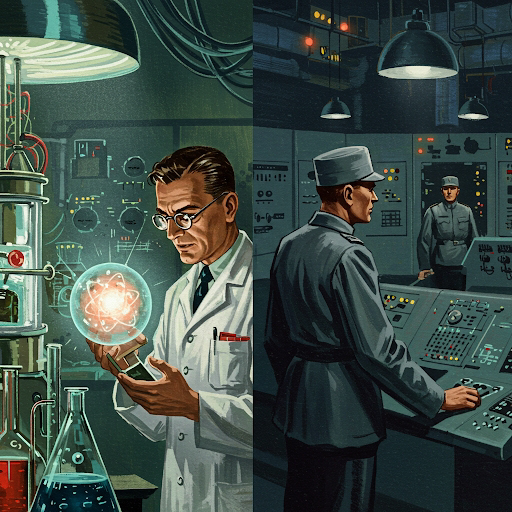The 1950s were a defining decade for science fiction and horror, marked by the tension between military might and the fear of unchecked scientific progress. Emerging from the devastation of World War II and entering the anxiety-laden Cold War era, these films and stories reflected the collective psyche of a world grappling with unprecedented power and rapid technological advancement. Through radioactive monsters, alien invasions, and rogue scientists, these narratives explored what happens when power—military or scientific—goes unchecked.
Decades later, the themes of "might is right" and "science without restrictions" remain relevant, highlighting the enduring resonance of 1950s speculative fiction in a world still navigating the ethical challenges of power and progress.
---
### **The 1950s: A Context of Paranoia and Power**
The 1950s saw the rise of atomic-age fears and the militarization of technology. The devastation wrought by the atomic bomb in Hiroshima and Nagasaki was fresh in the public consciousness, and the burgeoning arms race between the United States and the Soviet Union underscored the precariousness of military dominance. Meanwhile, rapid advances in science, from nuclear energy to space exploration, evoked both wonder and terror.
Movies like *The Day the Earth Stood Still* (1951) and *War of the Worlds* (1953) explored humanity's hubris in the face of greater cosmic forces, often suggesting that militaristic aggression was not the solution. Conversely, films like *The Thing from Another World* (1951) and *Them!* (1954) showcased the danger of ignoring or underestimating the unknown—whether it be alien invaders or giant ants spawned by radiation. Central to these narratives was the fear of losing control, whether to nature, technology, or an authoritarian regime.
---
### **Might is Right: The Dystopian Path of Militarism**
The notion that brute force and military might are the ultimate arbiters of survival permeates much of 1950s speculative fiction. This "might is right" philosophy is critiqued in films like *Godzilla* (1954), where humanity's obsession with weaponry and destruction directly leads to the creation of a nearly unstoppable force of nature. In these stories, military power is often depicted as a double-edged sword, capable of both protection and annihilation.
The resonance of this theme today is undeniable. From the proliferation of nuclear weapons to the militarization of space, humanity's reliance on force continues to raise questions about ethical boundaries. The tension between security and survival mirrors the dilemmas faced in the 1950s, especially as modern technologies like artificial intelligence and cyberwarfare add new layers to the equation.
### **Science Without Restrictions: The Frankenstein Complex**
Alongside the critique of militarism was a growing fear of science unleashed without moral or ethical considerations. The figure of the mad scientist became a staple of the era, embodying humanity's anxiety about its own curiosity. Films like *The Fly* (1958) and *Forbidden Planet* (1956) warned of the dangers of scientific arrogance, where the quest for knowledge leads to unintended and often catastrophic consequences.
The fears expressed in these stories resonate in contemporary debates about emerging technologies such as genetic engineering, artificial intelligence, and climate engineering. CRISPR, for example, has the potential to cure diseases but also raises concerns about "designer babies" and unforeseen ecological impacts. Similarly, AI development holds immense promise but is shadowed by warnings of automation-driven job loss, surveillance, and the creation of autonomous weapons.
---
### **The Ongoing Struggle for Balance**
What made 1950s speculative fiction so potent was its ability to dramatize the clash between unchecked power and the need for accountability. These stories often concluded with a moral lesson: the importance of humility, collaboration, and responsibility in the face of overwhelming forces. Such messages remain vital today as humanity confronts challenges ranging from climate change to geopolitical conflict.
The tension between "might is right" and "science without restrictions" plays out in real-time, as governments, corporations, and individuals wrestle with the consequences of their actions. For example:
- The ongoing debate about nuclear energy highlights the balance between its potential to reduce carbon emissions and the dangers of accidents and weaponization.
- Military strategies increasingly incorporate AI and drones, raising questions about autonomy and ethical use.
- The regulation of genetic research remains a hot-button issue, as governments try to prevent misuse while encouraging innovation.
---
### **Why These Themes Endure**
The enduring power of 1950s horror and sci-fi lies in their ability to crystallize universal fears about human nature. At their core, these stories explore the tension between power and responsibility, a struggle that has defined humanity’s history and will likely continue to do so. As we move further into the 21st century, the lessons of the atomic age remain strikingly relevant. They remind us that unchecked power, whether wielded by the military or the scientist, is as much a danger today as it was during the dawn of the atomic era.
In a time of accelerating technological change and global tensions, the warnings of 1950s speculative fiction echo louder than ever. Will humanity learn to temper its power with wisdom, or are we destined to repeat the mistakes of the past? The answer lies in how we confront the ethical dilemmas of our age, guided by the cautionary tales of a bygone era.

No comments:
Post a Comment